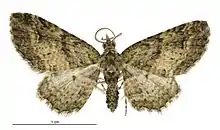| Pasiphila charybdis | |
|---|---|
 | |
| Scientific classification | |
| Domain: | Eukaryota |
| Kingdom: | Animalia |
| Phylum: | Arthropoda |
| Class: | Insecta |
| Order: | Lepidoptera |
| Family: | Geometridae |
| Genus: | Pasiphila |
| Species: | P. charybdis |
| Binomial name | |
| Pasiphila charybdis | |
| Synonyms[2] | |
| |
Pasiphila charybdis is a species of moth in the family Geometridae. It is endemic to New Zealand.[1][3]
Taxonomy
This species was first described by Arthur Gardiner Butler in 1879 and named Helastia charybdis using specimens collected by F. W. Hutton in Dunedin.[4][2] In 1879, thinking he was describing a new species, Butler also named this species Helastia calida.[4] George Hudson, also thinking he was describing a new species, named it Chloroclystis antarctica in 1898.[5] In 1917 Meyrick placed this species within the genus Chloroclystis and synonymised Helastia calida with it.[6] Hudson discussed Chloroclystis charybdis in his 1928 book The butterflies and moths of New Zealand but said he was unacquainted with the species.[7] In 1971 John S. Dugdale placed this species in the genus Pasiphila.[8] Dugdale confirmed this placement in 1988 and synonymised C. antarctica with P. charydbis.[2] The male holotype specimen is held at the Natural History Museum, London.[2]
Description
.jpg.webp)
Hudson described the larvae of this species as follows:
The larva of this species, which feeds on the common Veronica in December, is, when full-grown, about 3⁄4 in. in length, rather attenuated anteriorly, almost uniform, dark reddish-brown, darker on the sides. The head is reddish, and there are traces of several longitudinal lines in younger larvae. Others are dull yellowish-brown, with the lines plainer and the prolegs pale-yellow ; but as the larva is so extremely variable a detailed description hardly appears possible.[9]
Butler described the adults of this species as follows:
primaries above smoky-grey, crossed by about eight zigzag blackish lines in pairs, forming indications of four bands which are most strongly defined upon the costa ; a whitish-edged black lunule between the last two bands ; the last band partially filled in with sandy-whitish and brown ; fringe whitish flesh-coloured intersected by a grey line and interrupted at the terminations of the veins by blackish spots; secondaries pale smoky-grey, the veins black spotted with whitish ; extreme outer margin black ; fringe as in the primaries ; body brownish-grey, head yellowish ; antennae smoky-grey, strongly pectinated ; under surface sericeous grey ; markings of upper surface ill-defined ; discocellulars black ; primaries with pale reddish cupreous costal area; secondaries with a series of short black dashes beyond the cell; fringe paler than the rest of the wings, spotted with dark grey. Expanse of wings 10+1⁄2 lines.[4]
When discussing this species Dugdale stated:
Gathered under this name are the intricately patterned brown and green "species" with one spine-like cornutus on the aedeagal vesica.[2]
Habitat and hosts
The larval hosts of this species are plants in the genus Veronica.[9] Larvae have been successfully raised on Hebe
Life cycle
The pupa of this species can be found enfolded with silk between two leaves of its larval host.[9] The adults of this species are on the wing from December.[9]
References
- 1 2 "Pasiphila charybdis (Butler, 1879)". www.nzor.org.nz. Landcare Research New Zealand Ltd. Retrieved 15 May 2018.
- 1 2 3 4 5 John Stewart Dugdale (23 September 1988). "Lepidoptera - annotated catalogue, and keys to family-group taxa". Fauna of New Zealand. Department of Scientific and Industrial Research. 14: 187. doi:10.7931/J2/FNZ.14. ISSN 0111-5383. Wikidata Q45083134.
- ↑ Gordon, Dennis P., ed. (2010). New Zealand inventory of biodiversity: Kingdom animalia: chaetognatha, ecdysozoa, ichnofossils. Vol. 2. p. 460. ISBN 978-1-877257-93-3. OCLC 973607714. OL 25288394M. Wikidata Q45922947.
- 1 2 3 Arthur Gardiner Butler (1879). "On a small collection of Heterocerous Lepidoptera, from New Zealand". Cistula entomologica. 2: 503–504. Wikidata Q104215588.
- ↑ George Vernon Hudson (1898), New Zealand moths and butterflies (Macro-lepidoptera), Illustrator: George Hudson, London, p. 42, doi:10.5962/BHL.TITLE.7912, OCLC 980865393, Wikidata Q19073637
{{citation}}: CS1 maint: location missing publisher (link) - ↑ Edward Meyrick (December 1917). "Revision of New Zealand Notodontina". Transactions and Proceedings of the New Zealand Institute. 49: 253. ISSN 1176-6158. Wikidata Q110727829.
- ↑ George Vernon Hudson (1928), The butterflies and moths of New Zealand, Illustrator: George Hudson, Wellington: Ferguson and Osborn Limited, p. 93, LCCN 88133764, OCLC 25449322, Wikidata Q58593286
- ↑ Dugdale, J. S. (10 November 1971). "Entomology of the Aucklands and other islands south of New Zealand: Lepidoptera, excluding non-crambine Pyralidae" (PDF). Pacific Insects Monographs. 27: 55–172. ISSN 0078-7515. Wikidata Q64006453.
- 1 2 3 4 George Vernon Hudson (1905). "On Macro-lepidoptera observed during the Summer of 1903–4, including a Note on the Occurrence of a Hawk-moth new to New Zealand". Transactions and Proceedings of the New Zealand Institute. 37: 360. ISSN 1176-6158. Wikidata Q113503791.